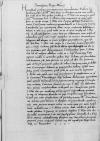List #5379
Ioannes DANTISCUS do Sigismund I JagiellonHeilsberg (Lidzbark Warmiński), 1542-11-09
Regest polski:
Pokojowiec powracający od księcia pruskiego [Albrechta Hohenzollerna] dostarczył Dantyszkowi list od niego. Książę poinformował, że dowiedział się od króla [Zygmunta I], iż król rzymski [Ferdynand I Habsburg] zwrócił się do monarchy polskiego z prośbą o wyznaczenie komisarzy do rozstrzygnięcia sporu dotyczącego ziem pruskich podległych królowi Polski z wielkim mistrzem Zakonu Krzyżackiego [Waltherem von Cronberg], zgodnie z ustaleniami podjętymi na sejmie Rzeszy w Ratyzbonie. Książę poprosił, by Dantyszek przekazał jemu oraz adresatowi swoją opinię na ten temat.
Dantyszek rozważył opisane królowi przez księcia postępowanie wielkiego mistrza podczas ostatniego sejmu Rzeszy w Norymberdze. Radzi, aby po wyznaczeniu komisarzy król zwrócił się do króla rzymskiego z prośbą o przedstawienie warunków rozstrzygnięcia sporu, które byłyby satysfakcjonujące dla wielkiego mistrza. Zdaniem Dantyszka obowiązek sformułowania takich warunków spoczywa na wielkim mistrzu jako stronie wnoszącej skargę.
Jeśli prośba o przedstawienie warunków spotka się z odmową, tak jak wielki mistrz uczynił to już podczas sejmu Rzeszy w Norymberdze, ponoszenie wydatków na komisarzy i organizację zjazdu będzie pozbawione sensu. Jeśli prośba zostanie spełniona, będzie można rozważać treść warunków, co pozwoli zyskać na czasie.
Swoje zdanie Dantyszek przedstawił, żeby uczynić zadość prośbie księcia. Z powodu słabości ręki nie napisał listu, ale podyktował go sekretarzowi, co wyjaśnił już w liście wysłanym przez pokojowca do króla przedwczoraj.
Rękopiśmienne podstawy źródłowe:
Publikacje:
| ||||||||
Tekst + aparat krytyczny + komentarz Zwykły tekst Tekst + komentarz Tekst + aparat krytyczny
 GStA PK, HBA, C 1, No. 861, f. 3r
GStA PK, HBA, C 1, No. 861, f. 3r
Serenissima
Humillimam perpetuae servitutis meae commendationem.
Rediens
Cuius licet pro hebetatione mea nihil, vel admodum parum, mihi inesse agnoscam, ut tamen eiusmodi postulationi vel aliqua ex parte satisfiat, perpendens ea, quae ipse illustrissimus dominus
Iis propositionibus habitis, consilium inire suaeque partis commissarios, quid facto sit opus, exacte instruere Serenissima Maiestas Vestra posset. Quae, inquam, propositiones si negabuntur, ut iam in
Quod pro mea simplicitate ad postulationem illustrissimi domini
Cui me supplicissime commendo et a Domino Deo aetatem valetudinemque prosperam atque omnium felicium successuum perpetuam precor accessionem intime atque animo cupidissimo.

